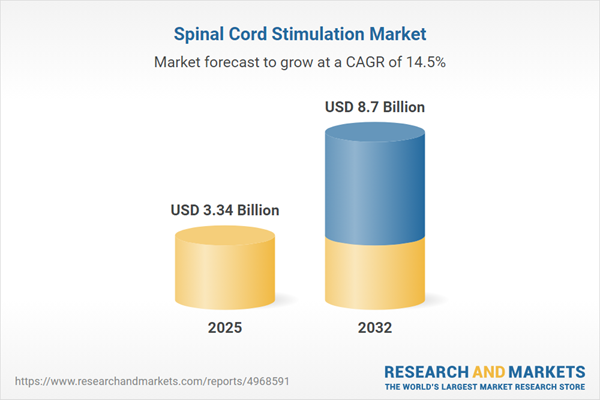Speak directly to the analyst to clarify any post sales queries you may have.
The spinal cord stimulation market is rapidly evolving as leading healthcare organizations implement advanced neuromodulation systems to elevate patient care, boost operational efficiency, and meet shifting regulatory standards.
Market Snapshot: Spinal Cord Stimulation Market Size and Growth
In 2024, the global spinal cord stimulation market reached USD 2.95 billion, with a projected increase to USD 3.34 billion in 2025. Sustained growth is anticipated with a 14.47% CAGR through 2032, driving market value toward USD 8.70 billion. Expansion is influenced by infrastructure modernization, expanding reimbursement for advanced pain therapies, and rising use of digital platforms that facilitate seamless device integration. The adoption of next-generation neuromodulation technologies continues to propel the market, ensuring spinal cord stimulation’s role within both established and high-growth healthcare environments.
Scope & Segmentation of the Spinal Cord Stimulation Market
- Product Types: Includes implantable pulse generators, available as rechargeable or non-rechargeable systems, as well as paddle and percutaneous multi-lead configurations. Essential accessories, such as anchors and extensions, support personalized clinician workflows and meet a broad array of patient requirements.
- Stimulation Types: High-frequency and low-frequency options allow clinicians to tailor neuromodulation protocols, supporting individualized therapy adjustments and alignment with clinical standards of care.
- Applications: Devices address chronic, intractable, ischemic, and neuropathic pain, fostering stronger care coordination among pain specialists, neurologists, and interdisciplinary networks throughout healthcare systems.
- End Users: Hospitals, ambulatory surgical centers, and specialized pain management clinics act as the principal users of spinal cord stimulation technologies, ensuring integration within varied care settings.
- Regional Coverage: The Americas, Europe, Middle East, Africa, and Asia-Pacific are all integral regions, each offering unique regulatory, economic, and adoption trends that shape market penetration and partnership models.
- Key Companies: Medtronic plc, Boston Scientific Corporation, Abbott Laboratories, Nevro Corp, Mainstay Medical Limited, Saluda Medical Pty Ltd, Nalu Medical, Stimwave Technologies, NeuroSigma, and GIMER MEDICAL continue to drive research, commercial alliances, and technical innovation to address evolving health system demands.
Key Takeaways for Senior Decision-Makers
- Advanced neuromodulation is increasingly favored as a core pain management strategy, influencing procurement and ushering in more effective non-opioid care pathways.
- Innovation in device design, such as miniaturized components and enhanced battery endurance, is simplifying clinical procedures and reducing the overall resource burden on provider teams.
- Digital integration enables seamless patient monitoring and management across both inpatient and outpatient care, facilitating coordinated transitions throughout patient pathways.
- Collaboration between manufacturers, providers, and operational leaders is enhancing compliance and encouraging broader adoption of spinal cord stimulation technologies.
- Remote monitoring systems and improved patient engagement platforms are making therapies more accessible, supporting continuous care, and contributing to more measurable clinical improvements.
Tariff Impact on Supply Chains and Market Accessibility
Recent U.S. tariffs on core spinal cord stimulation device components have prompted manufacturers to revisit their sourcing strategies. As a response, many companies are moving toward vertical integration and building resilient supplier partnerships to navigate uncertainties in global trade. Adaptive procurement solutions such as group purchasing and value-based contracting are supporting health organizations’ efforts to control costs and safeguard service continuity, reducing supply risks for care providers.
Methodology & Data Sources
This report synthesizes information through structured interviews with clinicians, deep analysis of supplier relationships, and comprehensive reviews of regulatory and academic data. The multi-source approach ensures the provided executive insights are precise, timely, and relevant to current market realities.
Why This Report Matters
- Offers actionable recommendations for senior leaders to refine capital expenditure and optimize purchasing policies in spinal cord stimulation procurement.
- Guides technology adoption to help organizations align operations and clinical processes with emerging advances and best practices in neuromodulation.
- Supports navigation of evolving regulatory demands and highlights new opportunities to implement innovative, digitally driven care models.
Conclusion
Senior executives can use this report to proactively maneuver industry shifts, strengthen strategic planning, and advance the adoption of future-ready pain management solutions within their organizations.
Additional Product Information:
- Purchase of this report includes 1 year online access with quarterly updates.
- This report can be updated on request. Please contact our Customer Experience team using the Ask a Question widget on our website.
Table of Contents
3. Executive Summary
4. Market Overview
7. Cumulative Impact of Artificial Intelligence 2025
Companies Mentioned
The companies profiled in this Spinal Cord Stimulation market report include:- Medtronic plc
- Boston Scientific Corporation
- Abbott Laboratories
- Nevro Corp
- Mainstay Medical Limited
- Saluda Medical Pty Ltd
- Nalu Medical, Inc.
- Stimwave Technologies, Inc.
- NeuroSigma, Inc.
- GIMER MEDICAL
Table Information
| Report Attribute | Details |
|---|---|
| No. of Pages | 187 |
| Published | October 2025 |
| Forecast Period | 2025 - 2032 |
| Estimated Market Value ( USD | $ 3.34 Billion |
| Forecasted Market Value ( USD | $ 8.7 Billion |
| Compound Annual Growth Rate | 14.4% |
| Regions Covered | Global |
| No. of Companies Mentioned | 11 |









